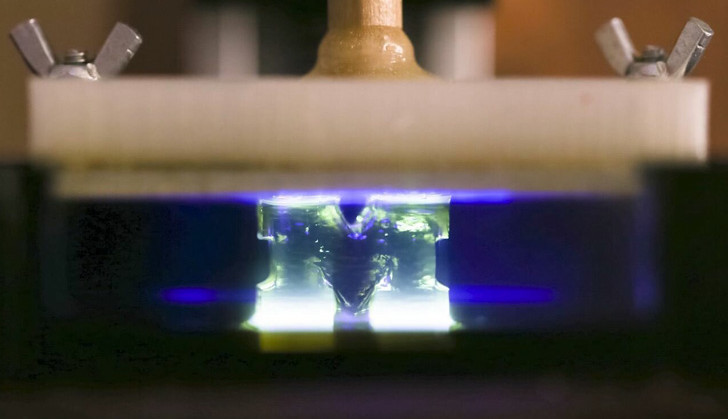3D printing with light is 100 times faster
January 22, 2019
on
on

A method of 3D printing called vat photopolymerisation uses a UV light directed into a tank of liquid resin to produced shaped layers of cured resin to build up a 3D printed part. A refinement to this process has been developed at the University of Michigan, which produces 3D objects up to 100 times faster than is possible using conventional 3D printing processes.
It is thought that this technique could be a game changer for making low-volume plastic forms without the need to invest in expensive tooling necessary to produce injection moulded items.
The University of Michigan logo is formed as it rises up from a pool of liquid resin. Video: Evan Dougherty, College of Engineering at the University of Michigan.
The structural integrity of objects printed using this process is clearly superior to objects made using conventional filament 3D printing methods because objects printed in that way have weak areas at the interfaces between layers.
The whole thing works, of course, only with special resins, because in conventional vat photopolymerisation systems, there is only one reaction. A photoactivator in the resin hardens when exposed to light. The process developed by the team at Michigan also uses a photoinhibitor in the resin that reacts to a different wavelength of light so that two different light sources can be used to define areas in the molten resin where solidification is inhibited or promoted.
The results of this research project are published in the journal Science Advances under the title ‘Rapid, continuous additive manufacturing by volumetric polymerization inhibition patterning’.
Source: 3D printing 100 times faster with light
It is thought that this technique could be a game changer for making low-volume plastic forms without the need to invest in expensive tooling necessary to produce injection moulded items.
The structural integrity of objects printed using this process is clearly superior to objects made using conventional filament 3D printing methods because objects printed in that way have weak areas at the interfaces between layers.
The whole thing works, of course, only with special resins, because in conventional vat photopolymerisation systems, there is only one reaction. A photoactivator in the resin hardens when exposed to light. The process developed by the team at Michigan also uses a photoinhibitor in the resin that reacts to a different wavelength of light so that two different light sources can be used to define areas in the molten resin where solidification is inhibited or promoted.
The results of this research project are published in the journal Science Advances under the title ‘Rapid, continuous additive manufacturing by volumetric polymerization inhibition patterning’.
Source: 3D printing 100 times faster with light
Read full article
Hide full article


Discussion (0 comments)